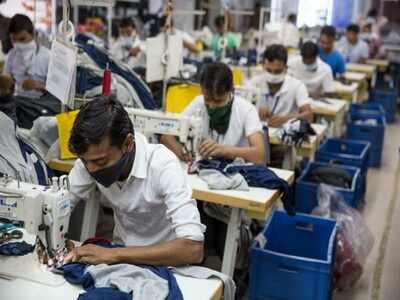
Highlights
NEW DELHI: A little over 6% of India's labour force was unemployed in 2017-18, the latest year for which government released data on Friday. The unemployment rate is identical to the rate mentioned in a report leaked in January this year, which had showed unemployment to be at a 45-year high.
The leaked report had triggered a major controversy, with the opposition parties slamming the government for its failure to create jobs and withholding the jobs report. The government had said that the report was only a “draft” and not final.
The report released on Friday by the National Statistics Office (NSO) said the new labour force survey needs to be seen as a new series for measuring employment and unemployment on annual basis.
“This is a new design and uses new metric and it would be unfair to compare it with the past,” Pravin Srivastava, the country’s chief statistician told reporters while releasing the report, a day after the Narendra Modi government was sworn-in. He denied that there was any political pressure to delay releasing the report.
The report showed the female unemployment rate in 2017-18 was at 5.7% while that for males was at 6.2%. The jobless rate for females in urban areas was in double digits at 10.8% while it was at 7.1% for males. In rural areas, the unemployment rate was at 5.8% for males and at 3.8% for females.
The NSO report also unveiled the results of a quarterly survey for urban areas for the period after 2017-18. The results showed that during October to December 2018, the unemployment rate was at 9.7%, higher than the 9.6% recorded in July-September 2018 and similar to the 9.7% in April-June 2018.
The quarterly survey showed that the unemployment rate for females was higher at 12.1%, while it was at 9% for males.
The annual survey showed 57.8% of male workers were self-employed in 2017-18 in rural areas, while the rate was at 57.7% for females. In urban areas 39.2% males and 34.7% females were self-employed.
The NSO said the first annual report is based on the data collected in Periodic Labour Force Survey (PLFS) during July 2017 to June 2018 and its estimates are linked to various aspects of employment and unemployment at the national and state levels. The quarterly bulletin contains data on employment and unemployment indicators in urban areas only.
The issue of jobs was a key election issue in the just concluded national elections. It has also been a flashpoint in debates between the government and opposition parties.
The results of the annual and quarterly survey pose a policy challenge for the new government and may prompt it to devise ways to create jobs across sectors as well as increase participation of women in the workforce.
The leaked report had triggered a major controversy, with the opposition parties slamming the government for its failure to create jobs and withholding the jobs report. The government had said that the report was only a “draft” and not final.
The report released on Friday by the National Statistics Office (NSO) said the new labour force survey needs to be seen as a new series for measuring employment and unemployment on annual basis.
“This is a new design and uses new metric and it would be unfair to compare it with the past,” Pravin Srivastava, the country’s chief statistician told reporters while releasing the report, a day after the Narendra Modi government was sworn-in. He denied that there was any political pressure to delay releasing the report.
The report showed the female unemployment rate in 2017-18 was at 5.7% while that for males was at 6.2%. The jobless rate for females in urban areas was in double digits at 10.8% while it was at 7.1% for males. In rural areas, the unemployment rate was at 5.8% for males and at 3.8% for females.
The NSO report also unveiled the results of a quarterly survey for urban areas for the period after 2017-18. The results showed that during October to December 2018, the unemployment rate was at 9.7%, higher than the 9.6% recorded in July-September 2018 and similar to the 9.7% in April-June 2018.
The quarterly survey showed that the unemployment rate for females was higher at 12.1%, while it was at 9% for males.
The annual survey showed 57.8% of male workers were self-employed in 2017-18 in rural areas, while the rate was at 57.7% for females. In urban areas 39.2% males and 34.7% females were self-employed.
The NSO said the first annual report is based on the data collected in Periodic Labour Force Survey (PLFS) during July 2017 to June 2018 and its estimates are linked to various aspects of employment and unemployment at the national and state levels. The quarterly bulletin contains data on employment and unemployment indicators in urban areas only.
The issue of jobs was a key election issue in the just concluded national elections. It has also been a flashpoint in debates between the government and opposition parties.
The results of the annual and quarterly survey pose a policy challenge for the new government and may prompt it to devise ways to create jobs across sectors as well as increase participation of women in the workforce.
Download The Times of India News App for Latest India News.
more from times of india news
Elections 2019
Trending Topics
LATEST VIDEOS
More from TOI
Navbharat Times
Featured Today in Travel
Quick Links
Rajasthan election 2019Andhra Lok Sabha electionGujarat Election 2019Karnataka Election 2019MP Lok Sabha electionMaharashtra election 2019West Bengal Lok SabhaTamil Nadu election 2019UP Election 2019Bihar election 2019UP Election DateAndhra Election DateBihar Election DateAndhra Assembly ElectionLok SabhaMP Election DateMaharashtra Election DateShiv SenaYSRCPTDPWB Election DateJDUCongressBJP newsGujarat Election DateSC ST ActUIDAIIndian ArmyISRO newsSupreme CourtRajasthan Election DateTelangana Election DateTamilrockers 2018Uttarakhand newsSikkim newsOrrisa newsKarnataka Election DateNagaland newsSatta KingManipur newsMeghalaya news
Get the app









